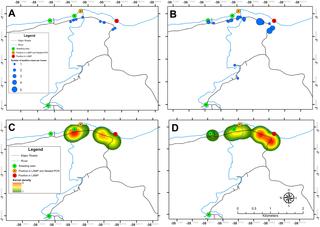PLOS Neglected Tropical Diseases ( IF 3.8 ) Pub Date : 2018-03-13 , DOI: 10.1371/journal.pntd.0006314 Javier Gandasegui , Pedro Fernández-Soto , Antonio Muro , Constança Simões Barbosa , Fabio Lopes de Melo , Rodrigo Loyo , Elainne Christine de Souza Gomes

|
Background
In Brazil, schistosomiasis is a parasitic disease of public health relevance, mainly in poor areas where Schistosoma mansoni is the only human species encountered and Biomphalaria straminea is one of the intermediate host snails. A nested-PCR based on a specific mitochondrial S. mansoni minisatellite DNA region has been successfully developed and applied as a reference method in Brazil for S. mansoni detection, mainly in host snails for epidemiological studies. The amplification efficiency of LAMP is known to be higher than PCR. The present work aimed to assess the utility of our previously described SmMIT-LAMP assay for S. mansoni detection in human stool and snail samples in a low-transmission area of schistosomiasis in the municipality of Umbuzeiro, Paraíba State, Northeast Region of Brazil.
Methodology/Principal findings
A total of 427 human stool samples were collected during June-July 2016 in the municipality of Umbuzeiro and an overall prevalence of 3.04% (13/427) resulted positive by duplicate Kato-Katz thick smear. A total of 1,175 snails identified as Biomphalaria straminea were collected from 14 breeding sites along the Paraíba riverbank and distributed in 46 pools. DNA from human stool samples and pooled snails was extracted using the phenol/chloroform method. When performing the SmMIT-LAMP assay a total of 49/162 (30.24%) stool samples resulted positive, including 12/13 (92.31%) that were Kato-Katz positive and 37/149 (24.83%) previously Kato-Katz negative. By nested-PCR, only 1/46 pooled DNA snail samples was positive. By SmMIT-LAMP assay, the same sample also resulted positive and an additional one was positive from a different breeding site. Data of human and snail surveys were used to build risk maps of schistosomiasis incidence using kernel density analysis.
Conclusions/Significance
This is the first study in which a LAMP assay was evaluated in both human stool and snail samples from a low-transmission schistosomiasis-endemic area. Our SmMIT-LAMP proved to be much more efficient in detection of S. mansoni in comparison to the 'gold standard' Kato-Katz method in human stool samples and the reference molecular nested-PCR in snails. The SmMIT-LAMP has demonstrated to be a useful molecular tool to identify potential foci of transmission in order to build risk maps of schistosomiasis.
中文翻译:

在巴西Umbuzeiro的血吸虫病低传播地区,使用LAMP测定法进行曼氏血吸虫病的现场调查:对人和蜗牛样品的评估
背景
在巴西,血吸虫病是一种与公共卫生有关的寄生虫病,主要发生在贫困地区,那里曼氏血吸虫是唯一遇到的人类物种,而Strmphina斑mph是中间寄主蜗牛之一。基于特定线粒体S的巢式PCR 。mansoni微型卫星DNA区域已成功开发,并在巴西用作S的参考方法。曼索尼检测,主要在寄主蜗牛中进行流行病学研究。已知LAMP的扩增效率高于PCR。本工作旨在评估我们先前描述的SmMIT-LAMP分析对S的效用。曼索尼 在巴西东北部帕拉伊巴州Umbuzeiro市血吸虫病低传播地区检测人类粪便和蜗牛样本。
方法/主要发现
2016年6月至7月在Umbuzeiro市收集了427份人类粪便样本,重复加藤-Katz浓密涂片检查总体阳性率为3.04%(13/427)。共有1,175只蜗牛被鉴定为Strmphia Biomphalaria采自帕拉伊巴河沿岸的14个繁殖场,分布在46个水池中。使用酚/氯仿方法提取人粪便样本和蜗牛的DNA。进行SmMIT-LAMP分析时,总共有49/162(30.24%)粪便样品呈阳性,包括Kato-Katz呈阳性的12/13(92.31%)和先前Kato-Katz呈阴性的37/149(24.83%)。通过巢式PCR,只有1/46个合并的DNA蜗牛样品为阳性。通过SmMIT-LAMP分析,同一样品也呈阳性,另外一个样品来自不同的繁殖地点也呈阳性。人类和蜗牛调查的数据用于通过核密度分析建立血吸虫病发病风险图。
结论/意义
这是首次对来自低传播血吸虫病流行地区的人类粪便和蜗牛样品中的LAMP测定进行评估的研究。我们的SmMIT-LAMP被证明在检测S方面效率更高。曼氏血吸虫相比于人粪便样品中的“金标准”改良加藤方法和蜗牛基准分子巢式PCR。SmMIT-LAMP已被证明是鉴定潜在传播病灶以建立血吸虫病风险图的有用分子工具。



























 京公网安备 11010802027423号
京公网安备 11010802027423号